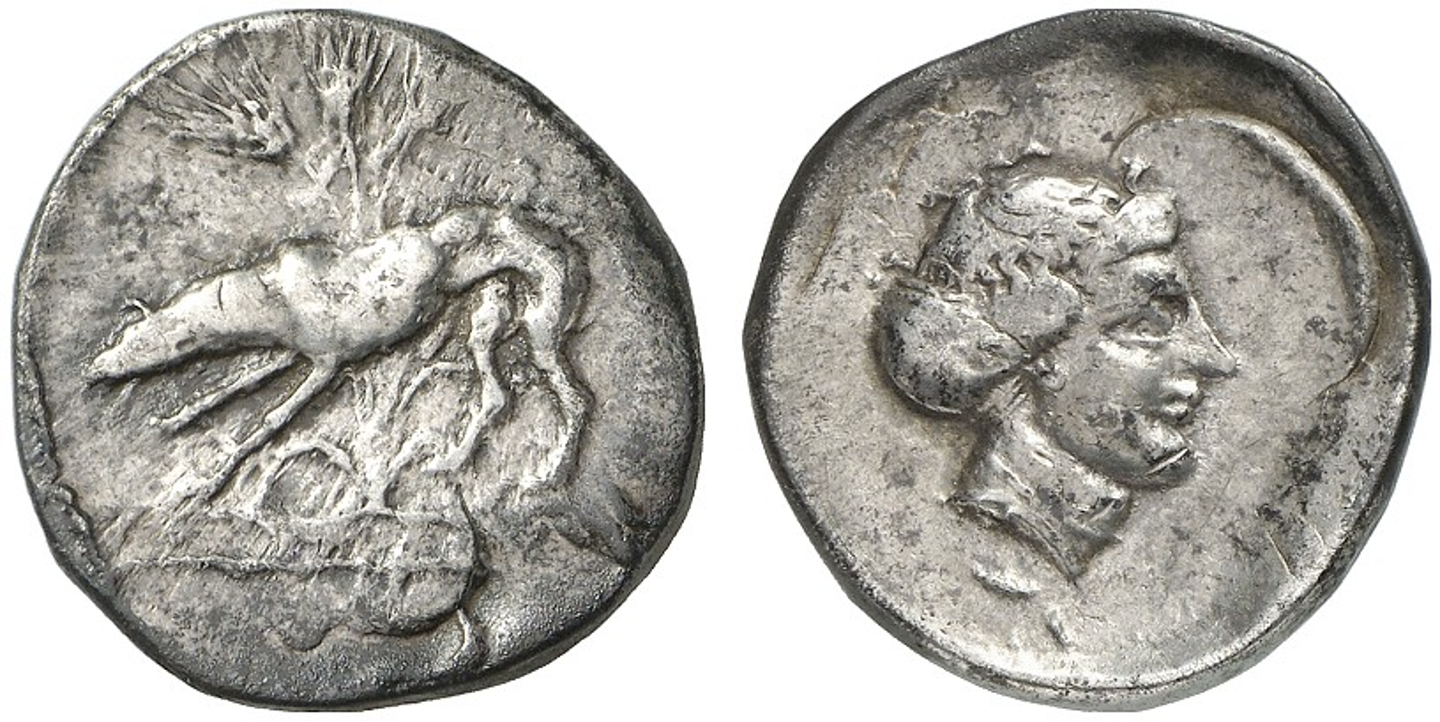412 BCE - 400 BCE | ΣΕΓΕΣΤΑZIB
Overstriking coin
SO 118 - Segesta (AR didrachm) over Corinth.png
[1]
Overstruck variety
Corinth Athena incuse square.jpeg
[2]
|
|
Sale(s)Sale(s) ᵖ:
|
Gorny & Mosch, 215, 14 Oct. 2013, 683.
|
|
|
|
Description
| ObverseInscription or printing placed on the obverse.:
|
Hound left. In the background, three grain ears.
|
ReverseInscription or printing placed on the reverse.:
|
ΣΕΓΕΣΤΑZIB (Greek) Head of nymph Aigiste right, wearing sphendone.
|
Mint and issuing power
| MintIdentifies the place of manufacture or issue of a numismatic object.:
|
Segesta
|
Ancient regionAncient region.
|
Sicily
|
Modern countryModern country: Italy
|
AuthorityIdentifies the issuing power. The authority can be "pretended" when the name or the portrait of X is on the coin but he/she was not the issuing power. It can also be "uncertain" when there is no mention of X on the coin but he/she was the issuing power according to the historical sources:
|
|
Chronology
| FromIdentifies the initial date in a range assigned in a numismatic context. 412 BCE toIdentifies the final date in a range assigned in a numismatic context.. 400 BCE
|
Classical 480-323 BC  periodTime period of the numismatic object. periodTime period of the numismatic object.
|
Physical description
MetalThe physical material (usually metal) from which an object is made.: Silver 
|
WeightWeight of the numismatic object (in grams). in grams: 8.438.43 g <br />8,430 mg <br />
|
DenominationTerm indicating the value of a numismatic object. Examples: tetradrachm, chalkous, denarius.: didrachm 
|
|
|
|
StandardStandard.: Attic
|
References
Description
| ObverseInscription or printing placed on the obverse.:
|
Head of Athena, wearing a Corinthian helmet, within incuse square (visible on reverse)
|
ReverseInscription or printing placed on the reverse.:
|
Pegasus (visible on obverse)
|
Mint and issuing power
| MintIdentifies the place of manufacture or issue of a numismatic object. ᵖ:
|
Corinth
|
Ancient regionAncient region. ᵖ
|
Peloponnesus
|
Modern countryModern country: Greece
|
AuthorityIdentifies the authority in whose name (explicitly or implicitly) a numismatic object was issued. ᵖ:
|
|
Chronology
| FromIdentifies the initial date in a range assigned in a numismatic context. toIdentifies the final date in a range assigned in a numismatic context..
|
periodTime period of the numismatic object.
|
Physical description
| DenominationTerm indicating the value of a numismatic object. Examples: tetradrachm, chalkous, denarius. ᵖ:
|
didrachm 
|
StandardStandard. ᵖ:
|
Aeginetic
|
References
References
- ^ Hurter, Silvia (2008), Die Didrachmenprägung von Segesta (mit einem Anhang der Hybriden, Teilstücke und Tetradrachmen sowie mit einem Überblick über die Bronzeprägung), Schweizer Studien zur Numismatik 1, Bern, 2008, 235 p., 27 cm
- ^ Hoover, Oliver D. (2012), The Handbook of Greek Coinage Series. 2. Handbook of the Coins of Sicily (Including Lipara). Civic, Royal, Siculo-Punic, and Romano-Sicilian Issues. Sixth to First Centuries BC, Lancaster-London, 489 p.
- ^ Ravel, Oscar E (1936), Les "Poulains" de Corinthe : monographie des statères corinthiens. Tome I: de 650 à 415 J.-C., Basel.
- ^ Hoover, Oliver D. (2014), Handbook of Greek Coinage Series 4. Northern and Central Greece : Achaia Phthiotis, Ainis, Magnesia, Malis, Oita, Perrhaibia, Thessaly, Akarnania, Aitolia, Lokris, Phokis, Boiotia, Euboia, Attica, Megaris and Corinthia, sixth to first centuries BC, Lancaster, lxxi, 563 p.

